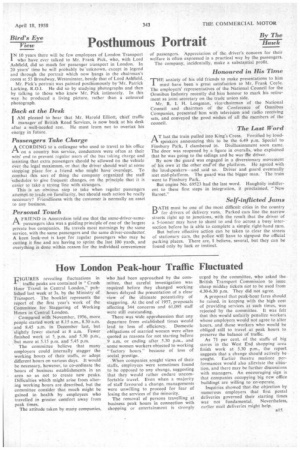Posthumous Portrait
Page 49

If you've noticed an error in this article please click here to report it so we can fix it.
I N 10 years there will be few employees of London Transport who have ever talked to Mr. Frank Pick, who, with Lord Ashfield, did so much for passenger transport in London. In 20 years' time he will probably be-unknown, except in legend and through the portrait which now hangs in the chairman's room at 55 Broadway, Westminster, beside that of Lord Ashfield.
Mr. Pick's portrait was painted posth-umously bylVIr. Patrick Larking, R.O.I. He did so by studying photographs and then by talking to those who knew Mr. Pick intimately. In this way he produced a living picture, rather than a coloured photograph.
Back at the Desk
I AM pleased to hear that Mr. Harold Elliott, chief traffic manager of British Road Services, is now back at his desk after a well-needed rest. He must learn not to overtax his energy in future.
Passengers Take Charge
ACCORDING to a colleague who used to travel to his office on a country bus service, conductors were often at their wits' end to prevent regular users of the bus taking charge and insisting that extra passengers should be allowed on the vehicle over the legal maximum, or that the driver should wait at some stopping place for a friend who might have overslept. To combat this sort of thing the company organized the staff -schedules' to give frequent changes, on the principle that it is easier to take a strong line with strangers.
This is an obvious step to take when regular passengers attempt to trade on familiarity, but should such action be really necessary? Friendliness with the customer is normally an asset to any business.
Personal Touch
/-1. A FRIEND in Amsterdam told me that the same-driver-same
passengers idea was a guiding principle of one of the largest private bus companies. He travels most mornings by the same service, with the same passengers and the same driver-conductor'. A keen look-out is kept for regular passengers who may be cutting it fine and are having to sprint the last 100 yards, and everything is done within reason for the individual convenience of passengers. Appreciation of the driver's concern for their welfare is often expressed in a practical way by the passengers. The company, incidentally, make a substantial profit.
Honoured in His Time
THE anxiety of his old friends to make presentations to him must have been a great satisfaction to Mr. Frank Coyle. The employers' representatives of the National Council for the Omnibus Industry recently did him honour to mark his retirement as joint secretary on the trade union side.
Mr. R. I. H. Longman, vice-chairman of the National Council and chairman of the Conference of Omnibus Companies, presented him with television and radio receiving sets, and conveyed the good wishes of all the members of the council.
The Last Word
A T last the train pulled into King's Cross. Fortified by loudin. speakers announcing this to be the 6.49 p.m. Special to Finsbury Park, I clambered in. Disillusionment soon came. The door was reopened by a figure in overalls, who explained that he was going to the sidings and he was the driver.
By now the guard was engaged in a diversionary movement of his own at the other encrof the platform. He agreed with the loudspeakers--and said so. Driver and guard 'eventually met mid-platform. The guard was the bigger man. The train went to Finsbury Park.
But engine No. 69523 had the last word. Haughtily indifferent to these first steps in integration, it proclaimed, "New Barnet."
Self-inflicted Jams
BATH must be one of the most difficult cities in the country for drivers of delivery vans. Parked cars line the narrow streets right up to junctions, with the result that the driver of a 5-tonner may have to shunt to and fro across a busy intersection before he is able to complete a simple right-hand turn.
But before effective action can be taken to clear the streets of stationary cars, the police will have to signpost the official parking places. There are, I believe, several, but they can be found only by luck or instinct.








































































































